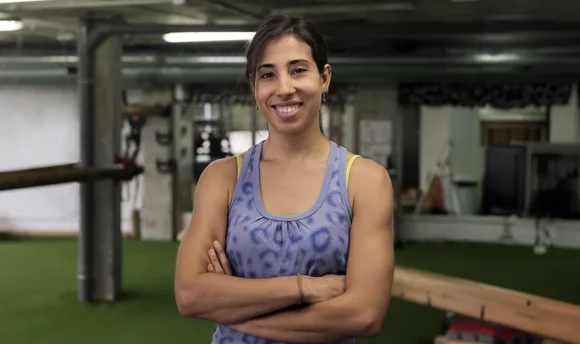Working Out 6 Days a Week Without Getting Tired
Working out 6 days a week isn’t for the faint of heart, but choosing to take on a workout routine of this intensity can fast-track you to better health and the body of your dreams.

There are many reasons you might feel tempted to squeeze 6 days of movement into your next workout plan.
Regular workouts can improve your brain health, strengthen your bones and muscles, keep your heart healthy, and help you move through the day with more vigor.
It’s only natural to want to squeeze all of these benefits from your workouts as often as you can.
But as with everything good, there is always that sweet spot where you can reap all the rewards while limiting the drawbacks.
In this article, we will be giving readers tips and workout ideas should they decide that working out 6 days a week is right for them.
Is Working Out 6 days a Week Too Much?
How many workouts per week is too much will depend on your fitness level. Is your body already used to working out? Do you have a solid understanding of how to tailor strength training workouts to target a specific muscle group?
It’s true that working out can reduce stress, but this only happens when our bodies are already acclimated to regular high-intensity workouts.
Exercise is stress-reducing in part because of the physical stress it puts on our bodies. This might seem kind of backward, but this activation of the fight or flight response followed by a return to homeostasis – or a state of balance – can actually have a calming effect on the body.
Someone who is used to strength training will be accustomed to dealing with a spike in cortisol and adrenaline while working out and, afterward, will be left feeling calm and relaxed.
Anyone not used to this fight or flight response will find the effects of this spike to be extremely taxing on the body.
Not taking on too much too soon, especially as a beginner, is important for optimizing results and reducing injury.
Another way to ensure your body can handle the stress of working out 6 days a week is to specifically engineer your training schedule in a way that allows for 24–48 hours of rest in between working specific muscle groups.
An upper body workout should be followed next by a lower body workout. You could also try to incorporate active recovery or use low-intensity recovery exercises like yoga or light cardio to give your muscles a chance to fully recover and grow stronger.
How often should I work out?
There is no magic number when it comes to working out, although the American College of Sports Medicine recommends doing moderate-intensity aerobic activity for 30 minutes five days per week or high-intensity aerobic activity for 20 minutes at least three days per week.
Doing a blend of cardio and strength training exercises is also recommended to keep your cardiovascular system healthy and your bones strong.
Doing a combination of these two exercise types will ensure you don’t miss out on the different benefits they offer.
How often you choose to work out and the time of the day you choose to do so will depend on things like your work schedule, fitness-related goals, and overall preference.
Running in the morning has its perks, but there’s also nothing wrong with going for a jog to blow off steam after work.
7 Tips for How to Work Out 6 Days a Week Without Getting Tired
One of the biggest problems people have when trying to take on a 6-day workout schedule is running out of energy halfway through the week.
Using the following tips will help you make it through a full week of workouts without feeling like you’re running on empty.
#1 Get plenty of sleep
The National Sleep Foundation recommends getting a minimum of 7–9 hours of sleep every night.
Sleep affects every tissue in the body, muscles included. A lack of sleep can decrease muscle protein synthesis, which is the process that uses amino acids to repair any small muscle tears that were created during exercise.
Another thing to note is that most HGH, also known as Human Growth Hormone, is released when you sleep.
This hormone is responsible for building and repairing healthy tissue in the body. It is essential for repairing the minor muscle damage that occurs during exercise.
Not getting enough sleep will affect your ability to recover post-workout, and if you’re working out every day, this is sure to impact your performance and cause you to be unable to stick to your new workout schedule.
#2 Eat nutrient-rich foods
Healthy food is what nourishes our bodies and gives them the energy they need to perform while exercising and recover afterward.
Although it’s important to ensure you are eating an overall balanced diet, there are staples you should ensure your diet is high in.
Protein
The amino acids found in protein are the building blocks of healthy muscles. Without them, we can expect our muscles to break down during our workouts and be left without the tools needed to repair themselves properly.
On average, you should aim to consume between 0.8–1 gram of protein for every pound you weigh to support healthy muscle growth.
Fats
Healthy fats are what the body uses for energy during low-intensity aerobic activity and are used for a number of other regular body processes throughout the day.
Fat also helps us feel fuller after meals, which is a big bonus if you are trying to lose weight.
It’s recommended that 10–35% of your calories daily should be consumed as healthy fats, monounsaturated and polyunsaturated fats. These can be found in things like vegetable oils and fish.
Carbohydrates
Last but definitely not least, you need to ensure you eat enough whole-grain carbohydrates daily.
If you are trying to lose weight, you might be avoiding foods high in fats and carbohydrates in an effort to limit your calories. And while these foods can get a bad rep, both are essential if you are trying to maintain a 6-days-a-week workout plan.
When you eat carbohydrates, they’re stored in your liver as glycogen, which is easily broken down into ATP. ATP is your muscles’ main source of energy, and without it, you can’t expect to have the energy you need to perform activities like weight training.
Every day you exercise, you deplete these glycogen reserves, so being intentional about eating enough to replenish them is important, especially on your rest days.
It is recommended that carbohydrates make up 45–65% of your total daily calories.
#3 Pencil in recovery days
Incorporating active recovery workouts is a useful way to stick to your workout plan while also giving your body a break from intense activities like strength training.
You can’t expect to maintain the same intensity throughout all of your workouts, and it’s important to be mindful of your body’s limitations. Not doing so can set you up for an injury.
On your recovery days, you can try going to a yoga class or enjoying a light cardio workout like a bike or hiking outdoors.
#4 Take supplements
Workout supplements come in various shapes and sizes. Some are made for losing weight; others are designed to help give you an extra pump during your workouts.
When it comes to working out 6 days a week, supplements can help keep you on track.
Pre-workout blends often contain high amounts of caffeine and creatine, both of which are designed to give users more energy during their workout. This can come in handy at the end of a long week.
Another popular supplement type is electrolytes, which are chock-full of the minerals sodium, calcium, and potassium. All of these are essential for muscle function and are lost when we sweat, making it easy to lose a healthy balance.
#5 Stay hydrated
Sweating is our body’s way of keeping us cool, and while it is effective, it also causes us to lose a lot of water. Replenishing your fluid levels by drinking a minimum of 2 liters of water a day is a must if you are working out 6 days a week, but 3 liters is preferable.
Not only does water improve our performance while we exercise, but it’s also an important part of the recovery process.
One of the biggest benefits of water post-workout is that it helps flush toxins out of the body.
Lactic acid is the byproduct of every workout session and is one of the causes of muscle fatigue and soreness.
Proper hydration can help flush this harmful acid out of your muscles, helping you get back on your feet faster.
#6 Focus on bodyweight training
When trying to knock out a workout 6 days a week, it’s a good idea – especially for those newer to working out – to focus on bodyweight training instead of using weights.
Bodyweight training has benefits like being a stellar cardiovascular workout, using full-body functional movements, and, most importantly, limiting muscle fatigue.
Using weights when you exercise will help you build bigger muscles faster, but this process of tearing and repairing the small fibers of your muscles can be taxing on your body.
Using just your body weight will help you lose body fat and leave you looking more toned, with smaller muscles. Most importantly, though, adding bodyweight exercises to your workout plan will make it more sustainable to do 6 days a week.
#7 Don’t forget a proper warm-up and cool-down
Another way to reduce muscle fatigue and soreness in the days after your workout is to be intentional about warming up and cooling down.
Doing dynamic warm-up exercises prepares your muscles and joints for activity. The loosening of the joints and increased blood flow to the muscles that happens when you warm up helps prevent injury and can make it easier for you to bounce back afterward.
Cool-down exercises are done after your workout in an effort to flush out any lingering lactic acid and keep muscles loose and limber. Putting your muscles into a relaxed state accelerates the healing process, especially after a high-intensity strength training workout.
6-Day Gym Workout Schedule
In this article, we’ve talked a lot about the physical toll of working out 6 days a week. And while setting your body up for 6 workouts a week is a challenge, there are other limitations to keep in mind.
Often, the hardest part of any fitness journey is consistency and accountability. Basically, will you show up for your workouts and continue cooking healthy, nutritious meals to support your new training plan?
In this next section, we are going to outline an example of a workout plan for all the days of the week. Pre-planning your workouts and penciling them into your calendar is one way for you to increase your likelihood of making it to the gym.
Monday
Beginner
Weightless upper-body workout:
- Push-ups – 45 seconds / 15 seconds rest
- Pike push-up – 45 seconds / 15 seconds rest
- Snow angels – 45 seconds / 15 seconds rest
- Plank-ups – 45 seconds / 15 seconds rest
- Push-up (right side) – 30 seconds / Push-up (left side) 30 seconds / 15 seconds rest
- Arm circles – 30 seconds / 15 seconds rest
- Plank – 30 seconds / 15 seconds rest
- Ankle taps – 60 seconds / 15 seconds rest
- Push-ups – 45 seconds / 15 seconds rest
- Roof raise – 45 seconds / 15 seconds rest
- Wide push-up – 30 seconds / 15 seconds rest
- Spiderman – 45 seconds / 15 seconds rest
- Planks – 45 seconds / 15 seconds rest
- Close push-up – 45 seconds / 15 seconds rest
- Delt raises – 45 seconds / 15 seconds rest
- Hip thrust – 45 seconds / 15 seconds rest
- Side plank (left side) – 45 seconds / 15 seconds rest
- Side plank (ride side) – 45 seconds / 15 seconds rest
- Push-up – 45 seconds / 15 seconds rest
- Jumping jacks – 45 seconds / 15 seconds rest
Advanced
Upper body push day:
- Inclined barbell bench press – 6–8 reps X 3–4 sets (heavy weight)
- Standing dumbbell shoulder press – 10–15 reps X 3–4 sets (lighter weight)
- Flat dumbbell press – 8–12 reps X 3–4 sets (moderate weight)
- Lateral raise – 10–15 reps X 2–3 sets (lighter weight)
- Seated decline cable fly – 10–15 reps X 2–3 sets (lighter weight)
- Incline dumbbell overhead extension – 10–25 reps X 2–3 sets (lighter weight)
Tuesday
Beginner
Weightless lower-body workout:
- Squats – 60 seconds
- Calf raises – 60 seconds
- Squats – 60 seconds
- Calf raises – 60 seconds
- Squats – 60 seconds
- Calf raises – 30 seconds / 30 seconds rest
- Inchworms – 60 seconds
- Fire hydrant (right) – 30 seconds / Fire hydrant (left) – 30 seconds
- Glute bridge – 60 seconds
- Inchworms – 30 seconds
- Glute bridge – 30 seconds
- Donkey kicks (right) – 30 seconds / Donkey kicks (left) – 30 seconds
- Glute bridge – 60 seconds / 30 seconds rest
- Side lunge (right) – 30 seconds / Side lunge (left) – 30 seconds
- Calf raises – 30 seconds
- Side lunge (right) – 30 seconds / Side lunge (left) – 30 seconds
- Calf raises – 30 seconds
- Side lunge (right) – 30 seconds / Side lunge (left) – 30 seconds / 30 seconds rest
- Sumo squats – 60 seconds
- Fire hydrant (right) – 30 seconds / Fire hydrant (left) – 30 seconds
- Sumo squats – 60 seconds
Advanced
Upper body pull day:
- Push-ups – 6–10 reps X 3–4 sets (bodyweight or assisted)
- Barbell row – 10–15 reps X 3–4 reps (lighter weight)
- Reverse grip lat pulldown – 8–12 reps X 3–4 sets (moderate weight)
- Chest supported rear deltoid row – 10–15 reps X 3–4 sets (lighter weight)
- Narrow grip barbell curl – 8–12 reps X 3–4 sets (moderate weight)
- Kneeling face pulls – 10–15 reps X 2 sets (lighter weight)
- Lying face pulls – 10–15 reps X 2 sets (lighter weight)
Wednesday
Beginner
Weightless core workout:
- Ab halos (counter-clockwise) – 30 seconds / Halos (clockwise) – 30 seconds / 30 seconds rest
- Frog crunch – 60 seconds / 30 seconds rest
- Russian rows – 60 seconds / 30 seconds rest
- Thread the needle (right) – 30 seconds / Thread the needle (left) – 30 seconds / 30 seconds rest
- Black widow knee slides – 60 seconds / 30 seconds rest
- Frog circles – 60 seconds / 30 seconds rest
- Sliding ab tucks – 60 seconds
Advanced
Lower body push and pull:
- Back squats or front squats – 6–10 reps X 3–4 sets (moderate weight)
- Hip thrusts – 12–15 reps X 3–4 sets (lighter weight)
- Split squats (2 sets Bulgarian and 2 sets contralateral) – 8–12 reps X 4 sets (lighter weight)
- Glute ham raise – 10–15 reps X 3–4 sets (lighter weight)
- Standing single leg calf raise – 6–10 reps X 2–4 sets (moderate weight)
- Seated calf raise – 10–15 reps X 2–4 sets (lighter weight)
Thursday
Stick to your workout schedule while also giving your body a break by penciling in an active recovery day.
Active recovery days are composed of light workouts that increase blood flow in order to flush any lingering lactic acid from the muscles, which can reduce soreness and aid in the recovery process.
Regardless of your skill level, this day can be spent walking, swimming, cycling, or light jogging. The key to keeping these activities low-intensity is to stay within the range of 30–60% of your maximum heart rate.
Your maximum heart rate can be calculated by subtracting your age from the number 220.
Friday
Beginner
Weightless full-body workout:
- Jumping jacks – 60 seconds
- Steam engines – 60 seconds
- Squats – 60 seconds
- Burpees – 60 seconds
- Superman – 30 seconds
- Planks – 30 seconds / 30 seconds rest
- Jump ropes – 60 seconds
- Calf raises – 30 seconds
- Arm circles – 60 seconds
- Ankle taps – 60 seconds
- Glute bridges – 60 seconds
- Push-ups – 30 seconds / 30 seconds rest
- Jumping jacks – 60 seconds
- Toe touches – 60 seconds
- Jump ropes – 60 seconds
- Plank – 30 seconds / 30 seconds rest
- Mountain climbers – 30 seconds / Side plank (right) – 30 seconds / Side plank (left) – 30 seconds
- Raise the roof – 30 seconds
- Flutter kicks – 30 seconds
- Jump ropes – 30 seconds
- Jumping jacks – 30 seconds
- Squats – 30 seconds
Advanced
Upper body push and pull:
- Incline dumbbell press – 6–10 reps X 3–4 sets (heavy weight)
- Chest supported row – 8–10 reps X 2–3 sets (moderate weight)
- Overhead press – 6–10 reps X 2–3 sets (moderate weight)
- Pull-ups or lat pulldowns – 8–10 reps X 2–3 sets (moderate weight)
- Incline dumbbell curls – 8–12 reps X 2 sets (lighter weight)
- Incline dumbbell extensions – 10–15 reps X 2 sets (lighter weight)
Saturday
Beginner
If you are new to working out and your body is still adjusting to working out 6 days a week, then it’s better to pencil in an extra active recovery day than it is to overwork your body.
You can’t expect to work out at the same intensity every single day; instead, treat yourself to some light cardio or yoga.
Advanced
Lower body:
- Barbell back squats – 6–10 reps X 2 sets (heavy weight), 12–15 reps X 1 set (lighter weight)
- Front squats – 6–10 reps X 2 sets (heavy weight), 12–15 reps X 1 set (lighter weight)
- Bulgarian split squats – 8–15 reps X 3 sets (lighter weight)
- Weighted hip thrusts – 10–15 reps X 3 sets
Sunday
You’ve made it through 6 days of workouts straight. That means it’s time to give your body a proper rest day.
Skip an active recovery day and instead do some light stretching or a yin yoga class. A deeply relaxing and meditative experience like yin yoga is often exactly what our bodies and minds crave after a full week of following a high-intensity workout schedule.
This could also be the perfect day for you to treat yourself to a massage.
A Word From Our Coach
You might see your favorite fitness influencers knocking out workouts 6 days a week and feel inspired to do the same. And while this is a worthwhile goal, it’s definitely not for the faint of heart.
A workout schedule of this intensity is sure to propel you forward on your fitness journey, but at what cost?
For more advanced athletes, upping the number of weekly workouts might make sense, but for beginners, it might end up doing more harm than good.
Any workout goal you set should help you feel better, and if you notice the scale tipping for the worst, don’t feel bad for penciling in an extra rest day.
Bottom Line
Taking on the challenge of working out 6 days a week is definitely possible, as long as you’re intentional about taking care of your body and not taking on too much too fast.
Things like drinking enough water, getting enough sleep, eating a balanced diet, and stretching after your workouts can make all the difference in a speedy recovery and set you up for success in your workouts day after day.
If you’re a beginner, start with bodyweight exercises to help you gain muscle and build strength before taking on any heavier weight training exercises. And regardless of where you’re at in your fitness journey, make sure to focus on different muscle groups each workout.

















































 Select your language:
Select your language: 








